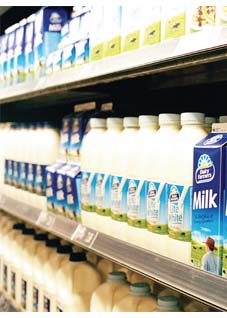
CONSUMPTION of ambient milk and other ambient liquid dairy products (LDP) across developed markets is projected to grow by 0.6% from 2008 to 2009. This growth comes during a period of worldwide economic recession, with total LDP consumption (ambient and chilled) in developed markets expected to dip by 1.2% from 2008 to 2009. "Although the recession has affected many sectors, it has not affected milk and liquid dairy consumption in the same way," said Dennis Jönsson, president and CEO, Tetra Pak Group, at a webcast for the Tetra Pak Dairy Index late in 2009. The Tetra Pak Dairy Index is a biannual report designed to help dairy producers identify new opportunities for growth, whilst offering all industry watchers information on the latest facts, figures, and trends related to the global dairy industry. "Milk is a healthy, nutritious and affordable food staple, which 44% of the world's population drinks every day. Whilst we have seen some consumers 'trade down' to less expensive products in the category, the market remains stable,"Mr Jönsson said According to the Index, total global consumption of milk and other LDP is expected to grow by 1.3% from 2008 to 2009. By the end of 2009, worldwide consumption of LDP is expected to reach 263 billion litres - up from 259 billion litres in 2008. This figure increases to 284 billion litres when soymilk and other dairy alternatives such as rice, nut and seed-based milks are included. Global growth predicted Tetra Pak is forecasting that total global LDP consumption will grow at a compound annual growth rate (CAGR) of 2.2% from 2009 to 2012 - in line with its projection earlier this year. Much of this growth will be led by developing markets - which have dr iven 95.8% of globa l LDP consumption growth from 2005 to 2008 - due to factors such as population growth, rising incomes and the relative novelty of liquid dairy products. Developed markets , which represent around one-third (32%) of global LDP consumption, face a tougher situation because many have already high per capita milk consumption rates. For example, Ireland leads the world in per capita consumption of chilled and ambient milk products at 160 litres per person per year compared to per capita consumption of just 19 litres per year in China. However, the Tetra Pak Dairy Index highlights that producers in developed markets are not standing still and are finding new ways to maintain growth. Michael Zacka, vice president, Marketing and Product Management, Tetra Pak, told the webcast that dairy producers in developed markets are introducing new products in line with consumer trends. "In developed markets such as North America, Western Europe and Australia,where milk consumption is already high, dairy producers are driving new growth by developing new products and consumption occasions, promoting milk in appealing new ways, catering to consumer trends and promoting the benefits of long-life products," said Mr Zacka. "For example in Canada, dairy producers are positioning long-life milk as an attractive product for use at vacation cottages and on camping trips where refrigeration is difficult. And in Spain, dairy producers have driven new growth by establishing a new segment in fortified and functional milk. This includes milk with added calcium for healthy bones and milk with Omega 3 for healthy hearts." Long-life LDP a key growth segment One of the key areas of growth worldwide - in both developed and developing markets - is ambient long-life LDP. In developed markets, the focus of the current issue of the Tetra Pak Dairy Index, ambient LDP consumption is expected to reach a CAGR of 0.7% from 2009 to 2012.

Driving this growth in developed markets are four main factorsAdidas

 iConnectHub
iConnectHub
 Login/Register
Login/Register Supplier Login
Supplier Login


























